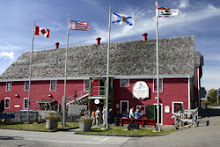The earliest European fishing vessels that plied their trade on the North Atlantic were square-rigged ships. Fleets from various countries, including France and England, ploughed their way through the often stormy seas, and perched themselves atop the Grand Banks for several months of fishing.
It wasn’t an easy job.
The weather was cold, wet and miserable, even on the best of days. Many of the men who worked aboard the vessels, particularly the crew aboard French ships, were working off debts. Some had been taken from debtor’s prisons and were forced to work as fishermen, having left loved ones at home, to fend for themselves.
The earliest of these fishing vessels were similar to the famous HMS Bounty, but were not quite that developed, in terms of steering. These vessels did not have a ship’s wheel, but were steered by the use of a tiller stick, located aft, below deck. The captain or navigator would stand on deck and shouted directions down through a grill, to the man in charge of the tiller. Thankfully, they rarely had need for quick, nimble maneuvering.
Square-rigged vessels require a larger sized crew than schooner-rigged ships. In the case of these early fishing vessels, the fishermen had to also be able to climb aloft and work the sails. On their voyage to and from the banks, the sails were often set in the same position for days on end, harnessing winds that regularly blew from a steady direction. While on the banks, they stayed in one area for days or weeks, depending on the abundance of fish.
Monday, January 26, 2009
Monday, January 19, 2009
Bluenose Builders
The original Bluenose was Canada’s most famous racing and fishing schooner. Launched at Lunenburg, Nova Scotia, on 26 March 1921, the vessel went on to be a great success as a fishing vessel and the undefeated Champion of the International Fishermen’s Series.
Many books and documentaries have been created, showcasing the talents of the Captain, Angus Walters, the crew members and the naval architect, William Roue. Given that the vessel fished, raced and toured as a sailing ambassador, the stories are rich with pure history: success, struggles, humour and human nature.
One area of the history is largely unknown, however. We do not have a definitive list of the names of those men who built the schooner, at the Smith and Rhuland Shipyard, between December 1920 and March 1921.
Allan Browne, of Lunenburg, is gathering information on this subject and would greatly appreciate assistance. According to Mr. Browne, "these men would have been born circa 1845 to 1906, being as young as 14 to as old as 75 in 1920."
The information, when compiled, will be made available to the Fisheries Museum of the Atlantic, as part of the archives. In turn, it will be public record, available to all who have an interest.
If you have names to add to the list of builders, please contact Allan Browne at abckits@hotmail.com or contact the Museum by either leaving a comment on this blog, or writing to getsonhe@gov.ns.ca
Many books and documentaries have been created, showcasing the talents of the Captain, Angus Walters, the crew members and the naval architect, William Roue. Given that the vessel fished, raced and toured as a sailing ambassador, the stories are rich with pure history: success, struggles, humour and human nature.
One area of the history is largely unknown, however. We do not have a definitive list of the names of those men who built the schooner, at the Smith and Rhuland Shipyard, between December 1920 and March 1921.
Allan Browne, of Lunenburg, is gathering information on this subject and would greatly appreciate assistance. According to Mr. Browne, "these men would have been born circa 1845 to 1906, being as young as 14 to as old as 75 in 1920."
The information, when compiled, will be made available to the Fisheries Museum of the Atlantic, as part of the archives. In turn, it will be public record, available to all who have an interest.
If you have names to add to the list of builders, please contact Allan Browne at abckits@hotmail.com or contact the Museum by either leaving a comment on this blog, or writing to getsonhe@gov.ns.ca
Subscribe to:
Comments (Atom)
